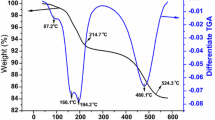Abstract
This work presents the study of optical constants and film thickness of blended organic thin films, emphasizing on the modeling procedure with modified genetic algorithm aided by absorption or transmittance spectra of both pure materials and the blends. Taking the blending of copper phthalocyanine (CuPc) and fullerene (C60) as an example, a simple, convenient and low-cost method for the determination of the optical constants and film thickness of blended organic thin films was demonstrated. New scheme for optical modeling of blended organic thin film was proposed by introducing peak energies of Cody-Lorentz oscillators of the pure materials, which were determined by fitting the film absorption of pure materials. These oscillators of pure materials could be recognized in the transmittance spectrum of their blends, and were further used as the initial searching ranges in the simulation of blended films. As a result, the constraint bounds of the unknown parameters were significantly reduced and modeling efficiency as well as fitting accuracy was improved. For instance, the fitting of the transmittance curves of blended films with different blending ratios reached reliable results in comparison with extinction coefficients obtained from experiment.
Similar content being viewed by others
References
Datta D, Tripathi V, Gogoi P, et al. Ellipsometric studies on thin film CuPC: C60 blends for solar cell applications. Thin Solid Films, 2008, 516: 7237–7240
Zhao X Y, Mi B X, Gao Z Q, et al. Recent progress in the numerical modeling for organic thin film solar cells. Sci China-Phys Mech Astron, 2011, 54: 375–387
Zhao X Y, Li Z G, Zhu T J, et al. Structure optimization of organic planar heterojunction solar cells. J Phys D-Appl Phys, 2013, 46: 195105
Pettersson L A A, Roman L S, Inganas O. Modeling photocurrent action spectra of photovoltaic devices based on organic thin films. J Appl Phys, 1999, 86: 487–496
Zhao X Y, Wang X Z, Lim S L, et al. Enhancement of the performance of organic solar cells by electrospray deposition with optimal solvent system. Sol Energy Mater Sol Cells, 2014, 121: 119–125
Wynands D, Erber M, Rentenberger R, et al. Spectroscopic ellipsometry characterization of vacuum-deposited organic films for the application in organic solar cells. Org Electron, 2012, 13: 885–893
Lai F, Lin L M, Gai R Q, et al. Determination of optical constants and thicknesses of In2O3: Sn films from transmittance data. Thin Solid Films, 2007, 515: 7387–7392
Datta D, Kumar S. Determination of optical constants of pentacene thin film by spectroscopic ellipsometry. Sol Energy Mater Sol Cells, 2010, 94: 420–424
El-Shazly E A A, Zedan I T, El-Rahman K F A. Determination and analysis of optical constants for thermally evaporated PbSe. Vacuum, 2011, 86: 318–323
Gao L H, Lemarch F, Lequime M. Comparison of different dispersion models for single layer optical thin film index determination. Thin Solid Films, 2011, 520: 501–509
Tikhonravov A V, Trubetskov M K, Amotchkina T V, et al. Modem design tools and a new paradigm in optical coating design. Appl Opt, 2012, 51: 7319–7332
Miloua R, Kebbab Z, Chiker F, et al. Determination of layer thickness and optical constants of thin films by using a modified pattern search method. Opt Lett, 2012, 37: 449–451
Budai J, Hanyecz I, Szilágyi E, et al. Ellipsometric study of SixC films: Analysis of Tauc-Lorentz and Gaussian oscillator models. Thin Solid Films, 2011, 519: 2985–2988
Gungo T, Saka B. Calculation of the optical constants of a thin layer upon a transparent substrate from the reflection spectrum using a genetic algorithm. Thin Solid Films, 2004, 467: 319–325
Khawaja E E, Durrani S M A, Al-Shukri A M. Simple method for determining the optical constants of thin metallic films from transmittance measurements. Thin Solid Films, 2000, 358: 166–171
Ferlauto A S, Ferreira G M, Pearce J M, et al. Analytical model for the optical functions of amorphous semiconductors from the near-infrared to ultraviolet: Applications in thin film photovoltaics. J Appl Phys, 2002, 92: 2424–2436
Orava J, Wágner T, Šik J, et al. Optical properties and phase change transition in Ge2Sb2Te5 flash evaporated thin films studied by temperature dependent spectroscopic ellipsometry. J Appl Phys, 2008, 104: 043523
Jellison G E J, Modine F A. Parameterization of the optical functions of amorphous materials in the interband region. App Phys Lett, 1996, 69: 371–373
Tauc J, Grigorovici R, Vancu A. Optical properties and electronic structure of amorphous germanium. Phys Status Solidi B, 1966, 15: 627–637
Cody G D, Pankove J I. Semiconductors and Semimetals. Orlando: Academic Press, 1984. 11–17
Chambers L. Handbook of Genetic Algorithm. America: Chapman & Hall/CRC, 2001. 85–90
Li X, Chen Y, Sang J, et al. CuPc/C60 bulk heterojunction photovoltaic cells with evidence of phase segregation. Org Electron, 2013, 14: 250–254
Opitz A, Wagner J. Molecular semiconductor blends: Microstructure, charge carrier transport, and application in photovoltaic cells. Phys Status Solidi A, 2009, 12: 2683–2694
WojdyŁa M, Derkowska B, Rebarz M, et al. Stationary and modulated absorption spectroscopy of copper phthalocyanine (CuPc) layers grown on transparent substrate. J Opt A-Pure Appl Opt, 2005, 7: 463–466
Zeng M, Yong K S, Kam Z M, et al. Effect of blend layer morphology on performance of ZnPc: C60-based photovoltaic cells. App Phys Lett, 2010, 97: 133304
Zhou Y, Taima T, Miyadera T, et al. Phase separation of co-evaporated ZnPc: C60 blend film for highly efficient organic photovoltaics. App Phys Lett, 2012, 100: 233302
Author information
Authors and Affiliations
Corresponding authors
Rights and permissions
About this article
Cite this article
Liang, Q., Chen, J., Li, X. et al. Convenient and inexpensive determination of optical constants and film thickness of blended organic thin film. Sci. China Phys. Mech. Astron. 58, 1–7 (2015). https://doi.org/10.1007/s11433-014-5482-5
Received:
Accepted:
Published:
Issue Date:
DOI: https://doi.org/10.1007/s11433-014-5482-5




